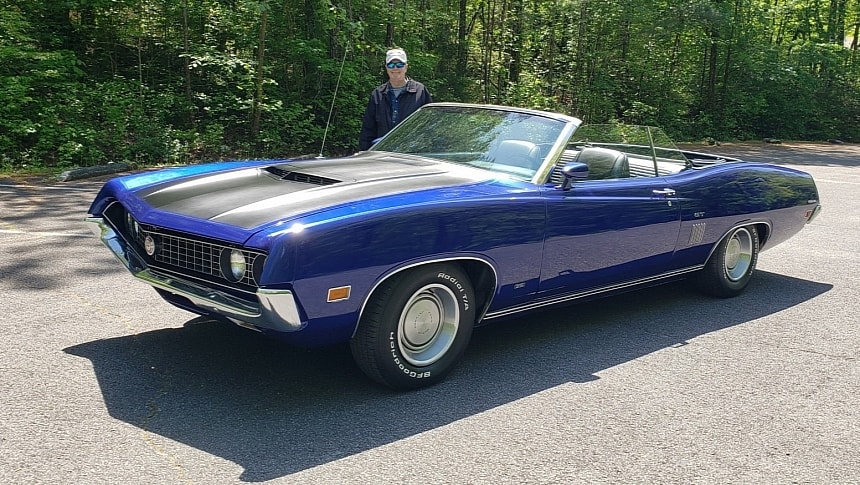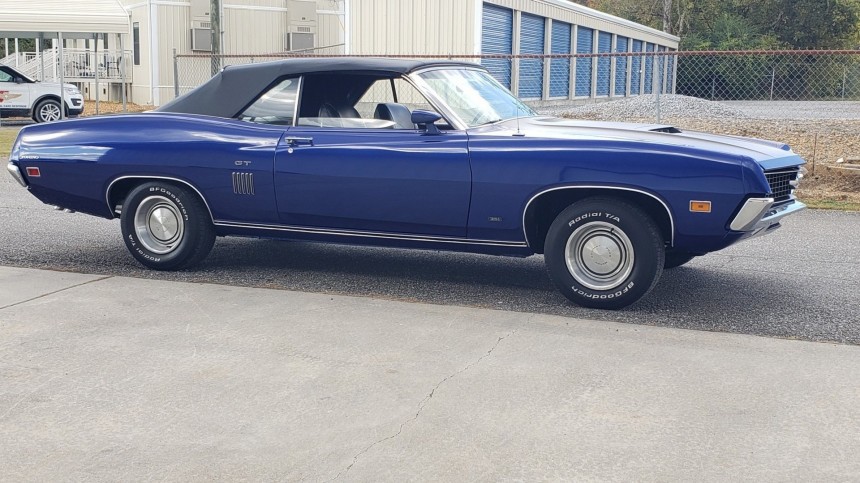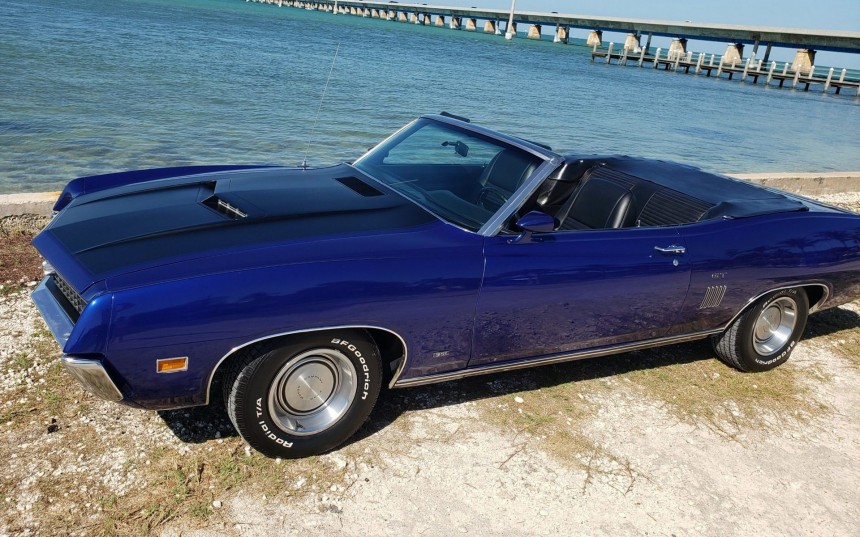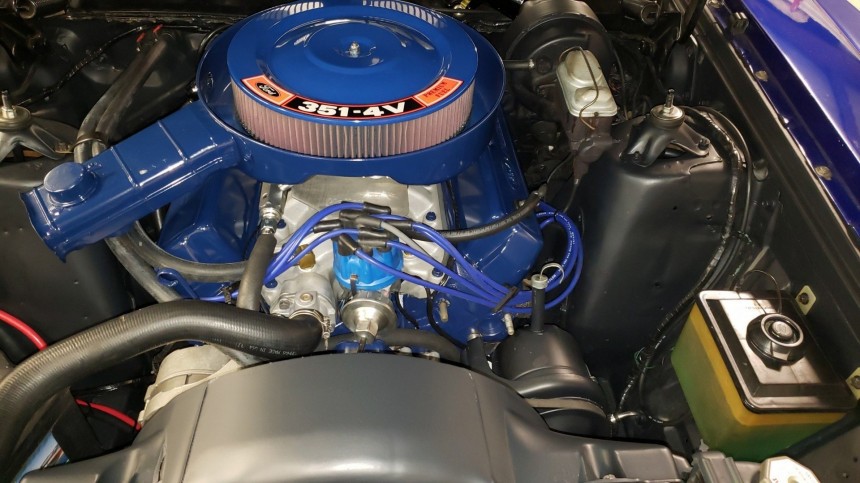Usually, cars and alcoholic beverages don’t go well together, but this 1970 Ford Torino GT convertible could prove us wrong. I don’t mean to imply that driving under the influence would be exonerated while at the wheel of this automobile. Still, something way funnier and benign revolves around the story of this family-owned FoMoCo rarity.
The 1970 Ford Torino marked a change of mind in Ford’s high offices, and the Fairlane family was demoted to sub-series ranks, being outcast by the Torino (until then, a trim of the Fairlane. All Detroit makers had a habit of juggling with nameplates back then). The Torino was the proper-sized muscle car – if we abide by the classic, widely accepted definition of the genre: ‘mid-sized body, hard-punching V8, two doors.’
In 1970, Ford noticed a worrying trend in the GT showroom performance: sales were dropping at a free-fall rate. From the 103,000 units recorded in the model's introductory year (74,000 hardtops, 24,000 fastbacks, 5,300 convertibles), the GT dropped to nearly 82,000 in 1969 and under 61,000 in 1970. In 1972, after a dismal 33,000-unit sales performance achieved in 1971, the nameplate was replaced by the Gran Torino.
That was a financial success, probably closely linked to the multitude of body styles offered. Until 1971, the Torino GT came in a two-door garment (the basic Torino covered the more-door sections, from sedans to wagons), with and without a solid roof overhead. The ragtop Torino GTs were never popular: out of 279,000 units built during the four model years (1968-1971), convertibles covered only 13,414.
From this aspect, 1970 is the best year for the droptop GTs, with 3,939 examples against a hardtop production of nearly 57,000 cars. In absolute values, the 1968 model reached higher numbers for the open-top line (5,310). However, the other two variants (hardtop and fastback) sold over 98,000 lots.
Also, in 1970, the notchback body style was dropped, leaving just fastbacks and convertibles to battle other muscle cars. It probably wasn’t convincing enough for the general public. Still, it was a solid proposal for a buyer from Atlanta, Georgia. In 1974, he bought a Torino GT droptop (model year 1970). In 1976, he was enjoying a drink (or several) with a relative who also happened to be a Ford guy and owned a 1972 F100 Sport Custom.
After several rounds, they ended up exchanging titles. Half a year after that memorable night out, they do it again. The story doesn’t end here: the GT’s owner’s nephew eventually bought the car. Incidentally, the nephew was also the son of the man with the F100. After some time, the GT returned to the uncle buyer from 1974, only to be purchased again by the same nephew several years later. (At this point, the silent question about what they were drinking is probably pointless).
Confused? So am I, if it's any comfort, but the fact is that the car made it to the present day after a restoration performed at an unspecified moment under the current ownership (of the nephew). Whatever the reason for this piston sparring in the family might have been, one thing is certain: the vehicle is a looker, although it took some sheet metal replacement and a paint job to get it to where it is now.
The floors have been redone some twenty years ago, and the drivetrain was also upgraded. The original 302 cubic-inch eight-cylinder motor (4.9-liter) that was standard equipment on the 1970 Torino GT is long gone. Instead, a 351 (Windsor, not Cleveland) proudly mumbles under the hood (hear it in the video).
The suspensions, fuel tank, fuel lines, carburetor, and wiring harness are all upgrades to the factory-installed parts. The story of the present powerplant is not detailed. Still, the motor is period correct – optional engines for the muscle Torino GT were the 351-cubic-inch mill (5.8-liter) with either a two-barrel carb and low 9.5:1 compression (250 hp) or the high-power alter ego, with a four-throat carb and high 11.0:1 compression, rated at 300 hp. The other powertrain choice was the 429-big-inch big-block. This seven-liter behemoth came in three guises (basic, Cobra, and Cobra Jet Ram-Air).
This particular example has a console-shifted three-speed SelectShift Cruise-O-Matic Drive transmission and a few touch-ups to the interior, like a retro-style stereo, some blue floor lights, and a new tach. That last bit might help indicate what the engine revs up to when the tires (wrapped on new wide steelies) start losing weight at redline RPMs. Check the video below for a quick demonstration that raises the question about the engine’s real output. Originally rated at 300 hp and 380 lb-ft (304 PS, 515 Nm), it would appear that this 351 has received some kind of special power (pun intended).
Although not original, this 1970 Torino GT is not far-fetched from the proverbial tree – I challenge anyone to say whether this Ford is authentic or not, using the 50-50 metric (50 feet away, at 50 mph; that’s 16 meters at 80 kph). Whoever invested time, money, energy, patience, and TLC in this car was aware that this was probably one of the last candidates for a fix-up to come out of Detroit. Not long after, cars gradually shifted from ‘Repair’ to ‘Replace’ paradigms.
This car is offered for sale now, and the current high bid is $18,500 at the time of press, a sum still below the seller’s lowest expectations. But, with three days still left of the auction, chances are someone will take this classic and rare convertible home.
In 1970, Ford noticed a worrying trend in the GT showroom performance: sales were dropping at a free-fall rate. From the 103,000 units recorded in the model's introductory year (74,000 hardtops, 24,000 fastbacks, 5,300 convertibles), the GT dropped to nearly 82,000 in 1969 and under 61,000 in 1970. In 1972, after a dismal 33,000-unit sales performance achieved in 1971, the nameplate was replaced by the Gran Torino.
That was a financial success, probably closely linked to the multitude of body styles offered. Until 1971, the Torino GT came in a two-door garment (the basic Torino covered the more-door sections, from sedans to wagons), with and without a solid roof overhead. The ragtop Torino GTs were never popular: out of 279,000 units built during the four model years (1968-1971), convertibles covered only 13,414.
Also, in 1970, the notchback body style was dropped, leaving just fastbacks and convertibles to battle other muscle cars. It probably wasn’t convincing enough for the general public. Still, it was a solid proposal for a buyer from Atlanta, Georgia. In 1974, he bought a Torino GT droptop (model year 1970). In 1976, he was enjoying a drink (or several) with a relative who also happened to be a Ford guy and owned a 1972 F100 Sport Custom.
After several rounds, they ended up exchanging titles. Half a year after that memorable night out, they do it again. The story doesn’t end here: the GT’s owner’s nephew eventually bought the car. Incidentally, the nephew was also the son of the man with the F100. After some time, the GT returned to the uncle buyer from 1974, only to be purchased again by the same nephew several years later. (At this point, the silent question about what they were drinking is probably pointless).
The floors have been redone some twenty years ago, and the drivetrain was also upgraded. The original 302 cubic-inch eight-cylinder motor (4.9-liter) that was standard equipment on the 1970 Torino GT is long gone. Instead, a 351 (Windsor, not Cleveland) proudly mumbles under the hood (hear it in the video).
The suspensions, fuel tank, fuel lines, carburetor, and wiring harness are all upgrades to the factory-installed parts. The story of the present powerplant is not detailed. Still, the motor is period correct – optional engines for the muscle Torino GT were the 351-cubic-inch mill (5.8-liter) with either a two-barrel carb and low 9.5:1 compression (250 hp) or the high-power alter ego, with a four-throat carb and high 11.0:1 compression, rated at 300 hp. The other powertrain choice was the 429-big-inch big-block. This seven-liter behemoth came in three guises (basic, Cobra, and Cobra Jet Ram-Air).
Although not original, this 1970 Torino GT is not far-fetched from the proverbial tree – I challenge anyone to say whether this Ford is authentic or not, using the 50-50 metric (50 feet away, at 50 mph; that’s 16 meters at 80 kph). Whoever invested time, money, energy, patience, and TLC in this car was aware that this was probably one of the last candidates for a fix-up to come out of Detroit. Not long after, cars gradually shifted from ‘Repair’ to ‘Replace’ paradigms.
This car is offered for sale now, and the current high bid is $18,500 at the time of press, a sum still below the seller’s lowest expectations. But, with three days still left of the auction, chances are someone will take this classic and rare convertible home.





















